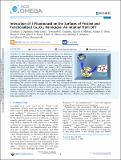Files in this item
Interaction of 5-fluorouracil on the surfaces of pristine and functionalized Ca12O12 nanocages : an intuition from DFT
Item metadata
| dc.contributor.author | Ogunwale, Goodness J. | |
| dc.contributor.author | Louis, Hitler | |
| dc.contributor.author | Unimuke, Tomsmith O. | |
| dc.contributor.author | Mathias, Gideon E. | |
| dc.contributor.author | Owen, Aniekan E. | |
| dc.contributor.author | Edet, Henry O. | |
| dc.contributor.author | Enudi, Obieze C. | |
| dc.contributor.author | Oluwasanmi, Esther O. | |
| dc.contributor.author | Adeyinka, Adedapo S. | |
| dc.contributor.author | Doust Mohammadi, Mohsen | |
| dc.date.accessioned | 2023-04-04T12:30:02Z | |
| dc.date.available | 2023-04-04T12:30:02Z | |
| dc.date.issued | 2023-04-18 | |
| dc.identifier | 283982968 | |
| dc.identifier | c3887d28-84ed-49cc-8784-c3f432cfe325 | |
| dc.identifier | 85151870966 | |
| dc.identifier.citation | Ogunwale , G J , Louis , H , Unimuke , T O , Mathias , G E , Owen , A E , Edet , H O , Enudi , O C , Oluwasanmi , E O , Adeyinka , A S & Doust Mohammadi , M 2023 , ' Interaction of 5-fluorouracil on the surfaces of pristine and functionalized Ca 12 O 12 nanocages : an intuition from DFT ' , ACS Omega , vol. 8 , no. 15 , pp. 13551-13568 . https://doi.org/10.1021/acsomega.2c03635 | en |
| dc.identifier.issn | 2470-1343 | |
| dc.identifier.other | RIS: urn:4276FD02DD0B4B83CCD760A0381B187A | |
| dc.identifier.uri | https://hdl.handle.net/10023/27332 | |
| dc.description.abstract | The utilization of nanostructured materials for several biomedical applications has tremendously increased over the last few decades owing to their nanosizes, porosity, large surface area, sensitivity, and efficiency as drug delivery systems. Thus, the incorporation of functionalized and pristine nanostructures for cancer therapy offers substantial prospects to curb the persistent problems of ineffective drug administration and delivery to target sites. The potential of pristine (Ca12O12) and formyl (−CHO)- and amino (−NH2)-functionalized (Ca12O12–CHO and Ca12O12–NH2) derivatives as efficient nanocarriers for 5-fluorouracil (5FU) was studied at the B3LYP-GD3(BJ)/6-311++G(d,p) theoretical level in two electronic media (gas and solvent). To effectively account for all adsorption interactions of the drug on the investigated surfaces, electronic studies as well as topological analysis based on the quantum theory of atoms in molecules (QTAIM) and noncovalent interactions were exhaustively utilized. Interestingly, the obtained results divulged that the 5FU drug interacted favorably with both Ca12O12 and its functionalized derivatives. The adsorption energies of pristine and functionalized nanostructures were calculated to be −133.4, −96.9, and −175.6 kcal/mol, respectively, for Ca12O12, Ca12O12–CHO, and Ca12O12–NH2. Also, both topological analysis and NBO stabilization analysis revealed the presence of interactions among O3–H32, O27–C24, O10–C27, and N24–H32 atoms of the drug and the surface. However, 5FU@Ca12O12–CHO molecules portrayed the least adsorption energy due to considerable destabilization of the molecular complex as revealed by the computed deformation energy. Therefore, 5FU@Ca12O12 and 5FU@Ca12O12–NH2 acted as better nanovehicles for 5FU. | |
| dc.format.extent | 18 | |
| dc.format.extent | 10786501 | |
| dc.language.iso | eng | |
| dc.relation.ispartof | ACS Omega | en |
| dc.subject | QD Chemistry | en |
| dc.subject | RM Therapeutics. Pharmacology | en |
| dc.subject | NDAS | en |
| dc.subject | SDG 3 - Good Health and Well-being | en |
| dc.subject | NIS | en |
| dc.subject | MCC | en |
| dc.subject.lcc | QD | en |
| dc.subject.lcc | RM | en |
| dc.title | Interaction of 5-fluorouracil on the surfaces of pristine and functionalized Ca12O12 nanocages : an intuition from DFT | en |
| dc.type | Journal article | en |
| dc.contributor.institution | University of St Andrews. School of Chemistry | en |
| dc.identifier.doi | https://doi.org/10.1021/acsomega.2c03635 | |
| dc.description.status | Peer reviewed | en |
This item appears in the following Collection(s)
Items in the St Andrews Research Repository are protected by copyright, with all rights reserved, unless otherwise indicated.

